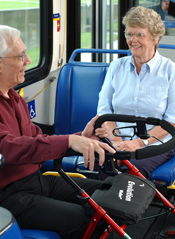Cross-posted at T4America's blog. Sean Barry is a communications associate at Transportation for America.
In a Streetsblog post last Thursday, Tanya tackled a question that has been marinating since Transportation for America released “Aging in Place, Stuck without Options,” addressing seniors’ mobility challenges:

Is it the job of overextended transit agencies – and the responsibility of taxpayers – to expand transit to all the inefficient places people have moved to, when they knowingly were moving away from urban amenities like transit in favor of the automobile? When that arrangement no longer works for people, do we encourage them to relocate in places that can better serve their needs, or do we aim to serve everyone’s needs exactly where they are, no matter where they are?
These are good questions, but there are some underlying assumptions that deserve a closer look. First, lets be fair: Automobile-dependent development has been the default setting for at least 60 years, so many people live in such places whether or not they “knowingly” rejected urban amenities and transit. And while it might make sense for some share of seniors to relocate, there simply isn’t enough adequate housing in close proximity to transit to accommodate the surging elder population — even if we could pry them away from support networks in their existing communities.
We don’t pretend for a minute that every cul-de-sac subdivision is entitled to its own transit route. But there are myriad ways that we could help to make the situation better, whether by broadening existing transit networks, expanding the supply of appropriate housing with access to transit or supporting educational programs that help to prepare seniors for getting around without driving.
In many inner suburbs, we have a ripe opportunity to change the dynamic. Many suburban communities are getting denser and more city-like in character, with dynamic job growth and greater proximity between employment and residential areas — Northern Virginia fits this description, for example. Under these circumstances, it not only makes sense to provide increased transportation options, but would be foolish not to. Both seniors and non-seniors deserve the chance to live in places with convenient and affordable access to transit if they choose.
Bottom line, there is plenty of low-hanging fruit. And T4’s report recommendations are incremental and achievable rather than pie-in-the-sky. We can start by preserving and expanding support for existing transportation systems, investing in programs like paratransit and ridesharing and continuing to allow state officials to “flex” a portion of their highways funds for other travel options. And, we can provide the funding and incentives for non-profit organizations and local communities to operate their own services in ways that make sense for them.
These are all ideas that Congress ought to consider as members deliberate over the next transportation bill.
Our recommendations are informed by the way things are, not how some might wish for them to be. That ought to resonate with those on the right who are wary of too much change too fast. Seniors are already aging in place, and we need to be prepared for it. By creating more options in more communities today, we’ll have a better handle on helping the next generation move around, too. And that makes it all the more important to get this right.





